Simon the Sorcerer Origins hands-on
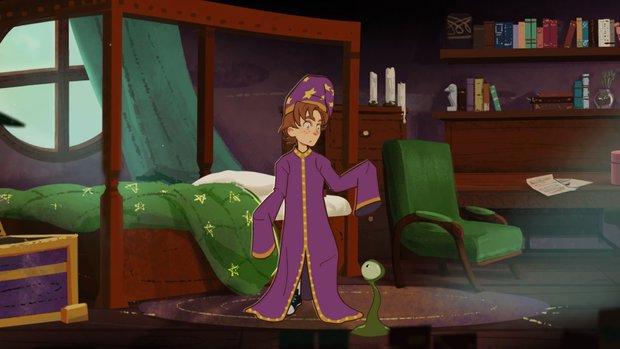
- 0 Comments
Debuting in 1993, the original Simon the Sorcerer could be (an admittedly young-ish) grandfather by now, but thanks to the magic(!) of technology, he not only retains his youth but will return younger than ever next month in the prequel by Smallthing Studios, Simon the Sorcerer Origins. I just finished playing a decent-sized early portion of the game, and while it didn’t reveal much of the greater story to come, it looks to be a highly polished production that clearly respects the franchise’s legacy (something that, let’s face it, not all of the sequels did).
This game takes place a few weeks prior to the events of the original game, when a school expulsion forces Simon to move to a new house with his family. Before he’s even unpacked, however, a plot is set in motion that follows a very familiar pattern. Stop me if you’ve heard this before: The preteen Simon unwittingly stumbles upon – and into – a portal that snatches him from his own world into a kind of medieval-style parallel fantasy world of mages and monsters. This being the FIRST time he’s ever been here (a fact he needs the odd fourth-wall break to remind himself of), it’s all new to Simon but should at least be vaguely familiar to long-time fans able to remember playing the first game 30-plus years ago.
After an opening segment that sees Simon fetch something blocking the new kitchen sink, with tutorial help from a helpfully naggy off-screen mom, he soon finds himself exploring an eerie marsh and dark forest – complete with bunny monster and web-wrapped giant spider morsels waiting for snacking – en route to Calypso’s cottage. Calypso, of course, is the wizened old wizard that played a significant role in Simon’s other adventures, and he does so once again here. Calypso informs Simon that he’s the key to an ancient prophecy by the “First Wizard” (who may or may not have been a woman in a very fake beard) that calls for an “impudent child” from another world to save the day. That sounds like smart-alecky Simon, all right, but first he’ll need some appropriate duds to go over his modern shorts and t-shirt. Fortunately there’s a robe and hat waiting for him, magically sized to fit in a more suitably youthful fashion than before.
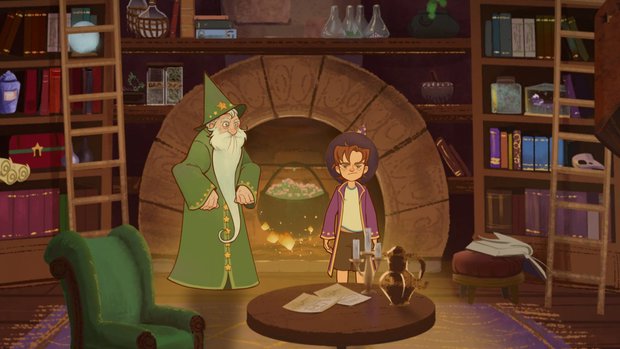
Simon’s goal is to find certain spell tomes scattered around the realm, but without any idea where to look, his first task is to gain entry to the local academy. That means a wand and student pass. And so he heads off to the nearby village, where he’ll make his way to a church with a cemetery out front, the pub in the Bloated Goat Inn, and Mundus’ Magic Shop, run by a “not at all creepy or unsettling old geezer” who’s even less creepily controlled like a marionette by an octopus. The Mundus puppet has exactly what Simon needs but is none too eager to give it up. And hey, maybe that loose dog named Chippy (now where have we heard that name before?) might know something about a purloined student card.
All this is presented in a cartoon art style with a lovely hand-painted look that nails the developer’s goal of emulating the “late 90s and early 2000s Disney productions.” Yes, gone are the days of pixel art for Simon. But it’s still in 2D, so as not to repeat THAT mistake again. (Simon 3D… shudder.) There’s a bit of ambient animation but a LOT of seamless, beautifully drawn mini-cutscenes showing important acts or plot points that take away control momentarily but never take you out of the game.
Also gone are the old SCUMM-style verb commands of yore, replaced here with a modern interface. Or rather, interfaces. This game lets you use traditional point-and-click controls, or a gamepad with two different options of its own: the “classic” style in which you maneuver the cursor for interactions, or a “direct control” mode in which you guide the protagonist and hotspots highlight whenever you draw near. And though I wasn’t able to test them, there will even be touch controls for Switch and Steam Deck. It’s the best of every world, offering players their preferred way to play on all its many different release platforms. There’s a commendable number of accessibility options as well, letting players adjust text size and backgrounds to suit their preferences, and even some visual choices like additional film grain, though I stuck with the crisp, clean default style.
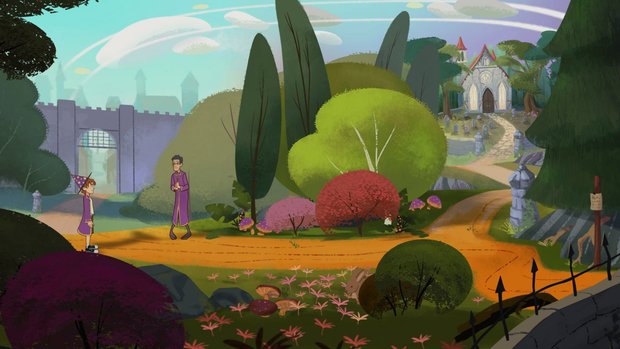
There are other quality-of-life features too, like a hotspot highlighter, a “magical diary” (read: objectives list) and a “map of displacement” for quick travel. The latter neatly adds a small pin to any major location Simon has discovered, while simultaneously dropping a LARGE pin into its real-world counterpart. You’ll still have to high-step it (Simon has an amusingly bouncy walking gait, though he will run with a double-click) through the various streets, alleys and pathways on foot, though, and I never had the opportunity to use the map shortcut.
The environments are sprinkled with inhabitants, both human and otherwise. Some you can talk to, like a jittery academy student and the innkeeper at the pub, while others are just there for scenery, like a troll selling flowers or the cat lazily napping atop the water well in the town square. The odd NPC will wander by in their own comings and goings, adding a welcome bit of animation, as does the occasional movement in the foreground, like a salamander skittering up the wall.
Each character you can talk to is fully voiced, and all of them are done well in the demo. The highlight, obviously, is Chris Barrie, actor for the original Simon (the talkie CD version), who reprises his role here. Barrie is in his 60s now, so it’d be a stretch for him to sound like a 12-year-old – and he doesn’t, but he delivers a fine performance that’s believable enough with a charming British accent, if not entirely age-appropriate. Of course he still gets to talk some sass, as Simon was always a sharp-tongued protagonist. The barbs are fairly gentle here, though (at least so far), with just some mild sarcasm and irritation uttered mostly to himself. He sneezes a lot too, for reasons I didn’t understand, though mainly when I paused for a moment; maybe he’s allergic to waiting?
As is series tradition, the world itself offers some fun visual nods to other fantasy franchises, video games and pop culture, from King Arthur’s sword to the “Sweetey Todd” barber shop (closed, alas) to a slimy purple tentacle cooped up in a trunk. There’s also a bit of self-referential humour, but so far none of it feels excessive, with a “show don’t tell” philosophy that avoids a sense of overkill. There are lots of hotspots in the main interactive settings, many of them purely optional for some yuks or additional background flavour, but the contextual smart cursor will indicate which ones aren’t strictly necessary.
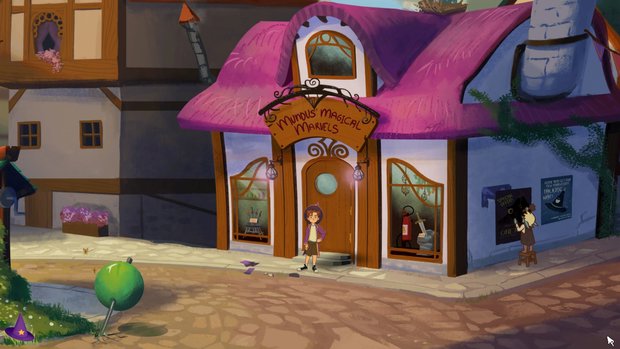
The demo’s music by composer Mason Fisher is content to sit comfortably in the background, but it’s a nice mix of whimsical, lightly jaunty fare with the occasional moody piece in darker moments, and even some suitably hallowed organ music in the church. Sound effects are either convincingly natural (frogs, owls, groaning wood) or fun, like the flushing sounds made by the church’s holy water dispenser, and you’ll look forward to the little chime that signals whenever you’ve accomplished something useful. Then there’s the widely publicized inclusion of Rick Astley’s “Together Forever” that promises to recur at various times throughout in different iterations.
There are puzzles to solve, mostly by acquiring inventory items and sometimes combining them in your much-bigger-on-the-inside wizard’s hat. I was pleased to see one dialogue “puzzle” as well, requiring you to successfully talk your way to your goal. It relies a bit too much on trial and error, but it makes for a welcome change. You can click ahead through dialogue lines, and fortunately your counterpart has infinite patience for you to start over and try again. It’s too bad the demo didn’t extend far enough for me to see the features I’m most excited about – namely the magic spells Simon learns and the different hats he’s able to wear, with varying effect on their stored contents. These are great concepts that I can’t wait to see in action.
Unfortunately, the demo didn’t really delve too deeply into the larger story, either. There’s an evil wizard with nefarious plans skulking around ancient ruins (not named here, but I’ll go out on a limb and suggest Sordid?) who seems destined to butt heads with Simon soon enough. But what, exactly, he’s up to I still don’t know. And while the promotional material for Origins promises it will bridge the gap narratively with the original game, there’s been no hint yet on how the two tie together. Which is fine, as these were just the first few hours of a full game that is projected to take 10-12 hours for a “hardcore” adventurer or 14-16 hours for a “casual” one (and probably adventure game website editors who are bad at puzzles; not naming any names).
As much as I’d have liked to dive further into the world of the boy wizard and his magical hat, at least there’s only a month to wait, as Simon the Sorcerer Origins is due to launch on October 28th on all major platforms. It’s too early to speak definitively about how it will all play out, but so far so good! It has the blessing of series creators Simon and Michael Woodroffe, and this early look suggests that after a few ill-advised breaks from the norm, Simon the Sorcerer is finally back on track with a pretty, polished production that shows there’s some magic left in the venerable old franchise after all.


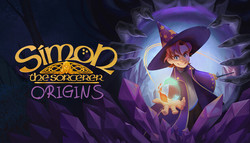



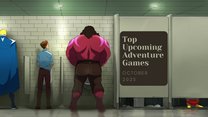




0 Comments
Want to join the discussion? Leave a comment as guest, sign in or register in our forums.
Leave a comment